Top image: View of the conference table at Cecilienhof Palace, scene of the Potsdam Conference in Potsdam, Germany. President Harry S. Truman is in left foreground. Adm. William Leahy is seated to the right of the President. British Prime Minister Winston Churchill is seated at upper left of table. Clement Attlee is seated two to the right of Mr. Churchill. Soviet leader Josef Stalin is at upper right of table. Soviet foreign minister Vyacheslav Molotov is to the immediate left of Mr. Stalin in the photo. Averell Harriman is standing at extreme left. “Scene of Potsdam Conference,” July 19, 1945, National Archives and Records Administration, Office of Presidential Libraries, Harry S. Truman Library, (NAID) 198890.
“So often in history has the dilemma of how to treat an aggressive nation baffled its conquerors!”
Herbert Feis, Between War and Peace: The Potsdam Conference
Between July 17 and August 2, 1945, Soviet leader Joseph Stalin, British Prime Minister Winston Churchill (replaced on July 26, 1945, by Prime Minster Clement Attlee), and US President Harry Truman met at Potsdam, Germany, to negotiate the terms for the end of World War II. Even though the Allies remained committed to fighting a joint war in the Pacific, mutual distrust stemming from differing views of what a postwar world should look like led to disagreements on several key issues. Consequently, some historians have pointed to the Potsdam Conference as one of several fissures between the Soviet Union and the West that set the stage for the Cold War.
The three most pressing issues discussed at Potsdam concerned how to handle a defeated Germany, the fate of Poland, and the final destruction of Japanese military power. Questions dealing with German reparations, the economic rehabilitation of Germany, Poland’s postwar borders, and the composition of Poland’s government proved to be the most contentious. The Big Three, however, also had to make decisions regarding the stabilization of China, Axis satellite states, and orderly population transfers.
Unlike the previous conferences at Tehran and Yalta, Stalin and his Western counterparts were becoming increasingly suspicious of each other’s postwar intentions. On the one hand, the United States and Great Britain feared a Soviet-backed communist domination of Europe, which drove their decision making at Potsdam. On the other hand, Stalin believed that his Western Allies did not appreciate the sacrifices made by the Red Army and Soviet citizens during the war, remarking at times that the West was committed to denying the Soviet Union appropriate compensation. As the historian Michael Neiberg argues in Potsdam: The End of World War II and the Remaking of Europe, the disagreements at Potsdam also depended on how each leader viewed history as much as each leader’s strategy and visons for a postwar world.
Differing World Views
Stalin came to Potsdam with the impression that the West had depended on the Soviet Union for victory in Europe. Estimates place Soviet military deaths in battle between 8.8 million and 10.7 million and civilian deaths at 14.6 million, which equated to about 13.9 percent of the country’s total prewar population. In comparison, Britain lost approximately 383,800 in battle and 67,000 civilians while the United States had about 416,800 deaths in battle and 1,700 civilian deaths. “Soviet loss and suffering played a profound role in the attitudes and behaviors of the Soviets at Potsdam,” argues Neiberg, which complicated matters since the Soviets possessed a desire for revenge that the West did fully comprehend and, therefore, “badly underestimated.”
Britain came to the table as they did during the 1919 Paris Peace Conference, which outlined the parameters of the Treaty of Versailles that ended World War I, with the same conviction: protecting the balance of powers in Europe. In 1919 Britain viewed France as the biggest threat to that balance, but now its leaders, especially Churchill, saw the Soviet Union as the greatest danger. Some within the British government even argued that communism was more menacing than Nazism, and prior to Potsdam, Churchill made it clear that the West would “respond in meaningful ways to Russian aggression.” As a result, the British foreign delegation advocated for policies aimed at containing both Germany and the Soviet Union.
The United States remained divided on how much of a threat the Soviet Union posed to European peace. While some officials, such as Admiral William Leahy, agreed with Churchill that one of the Soviet Union’s main goals was the spread of communism, others held a more optimistic view. Truman, for instance, thought the mistrust between Stalin and the West stemmed from miscommunication during the weeks between FDR’s death and the German surrender. He also believed that Soviet desires to have control over Poland, recover lands lost to the Japanese in 1905, and a guaranteed access to the Dardanelles were similar to those of Russian tsars. As a result, he did not think the West needed to fear Soviet power plays in other areas of the world.
George Kennan, who Neiberg maintains came the closest to predicting Stalin’s mindset, thought that the last three decades of revolution and total war had brought out the worst features of the Russian system, including “paranoia, a sense of insecurity, and a willingness for acts of cruelty.” Kennan and his supporters advocated for an acceptance of Soviet domination over the areas it already controlled as well as plans to divide Europe into two spheres of influence. The difficulty reading Soviet intentions increased in the weeks leading up to the Potsdam Conference as the Soviets began to limit the freedom of movement of American officials in Eastern Europe, which only heightened tensions among the Big Three.
Pre-Conference Challenges
One of the biggest challenges facing the Allies during the Potsdam Conference dealt with changes to the heads of government in the United States and Britain. During the interim months between Yalta and Potsdam, Franklin Roosevelt died, leaving an enormous void in US foreign policy. FDR had conducted most of US war diplomacy himself, often shutting his own State Department out of the process, which left Truman unprepared for his new role as a member of the Big Three. Conversely, in the middle of the Potsdam Conference, Britain’s Labor Party won the general election and Clement Attlee replaced Winston Churchill as Prime Minister. Similar to Truman, Attlee had served as Churchill’s deputy prime minister in a coalition government, but was rarely involved in making any key decisions.
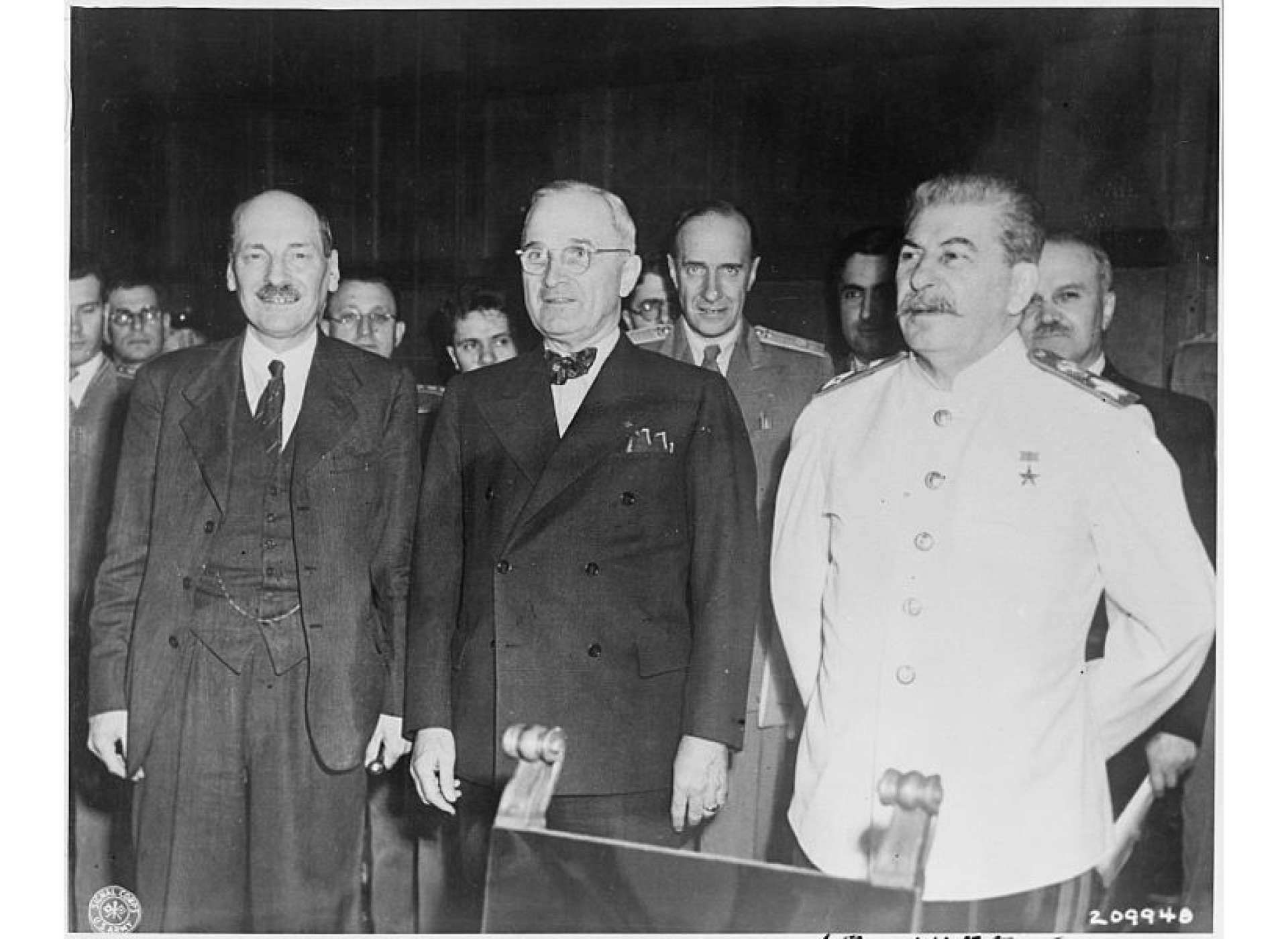
The new "Big Three" meet for the first time at the Potsdam Conference in Potsdam, Germany. Left to right: the new British Prime Minister Clement Attlee, President Harry S. Truman, and Soviet Prime Minister Josef Stalin. “The new Big Three meet for the first time at the Potsdam Conference,” July 29, 1945, National Archives and Records Administration, Office of Presidential Libraries, Harry S. Truman Library, (NAID) 198950.
While neither Truman nor Attlee made drastic deviations from their countries’ respective positions on key issues, both men brought new foreign delegations to Potsdam, which affected the conference proceedings. The introduction of new personnel within the US and British delegations also created challenges because some of the new diplomats held different views concerning the postwar world, the main goals of the Potsdam Conference, and the interpretation of agreements reached at Yalta than their predecessors.
Most notably, The Big Three disagreed about the purpose of the Potsdam Conference. Stalin reportedly saw Potsdam as “a conference to prepare for a future conference,” and repeatedly suggested dates for future meetings between the three heads of government. Truman, and Churchill before Attlee took over as Prime Minister, did not want the conference to turn into a forum in which dozens of questions would be debated. As he stated, “I was there to get something accomplished, and if we could not do that, I meant to go back home.” As the conference continued, Truman became more frustrated at the lack of firm agreements reached.
The introduction of new foreign delegations also caused disputes concerning the interpretation of agreements reached at Yalta. For example, while Truman thought the Yalta agreements offered multiple interpretations, Stalin believed everything that had to be discussed was set in stone. This disparity was particularly visible when the Big Three discussed the administration of the joint occupation of Germany, reparations policy for the defeated powers, and Poland’s postwar borders.
Solving the Problem of Germany
Prior to the Potsdam Conference, senior military leaders had worked out arrangements for the coordination and cooperation for a joint occupation of Germany. At the request of the United States and Britain, France joined as the fourth power to share the obligations of occupation, although the Soviets insisted that the French occupation zone be taken out of the Western zone. The Allies also agreed that all four power would have an equal vote in all decisions related to occupation policy.
Even though the three heads of government had already agreed to jointly occupy Germany after the war ended, they still need to formulate policies governing the administration of Allied occupation and the conditions of German surrender. Questions pertaining to the extermination of Nazi elements, the reformation of German political institutions, the regulation of economic affairs, and the extraction of reparations were all questions that needed to be answered at Potsdam.
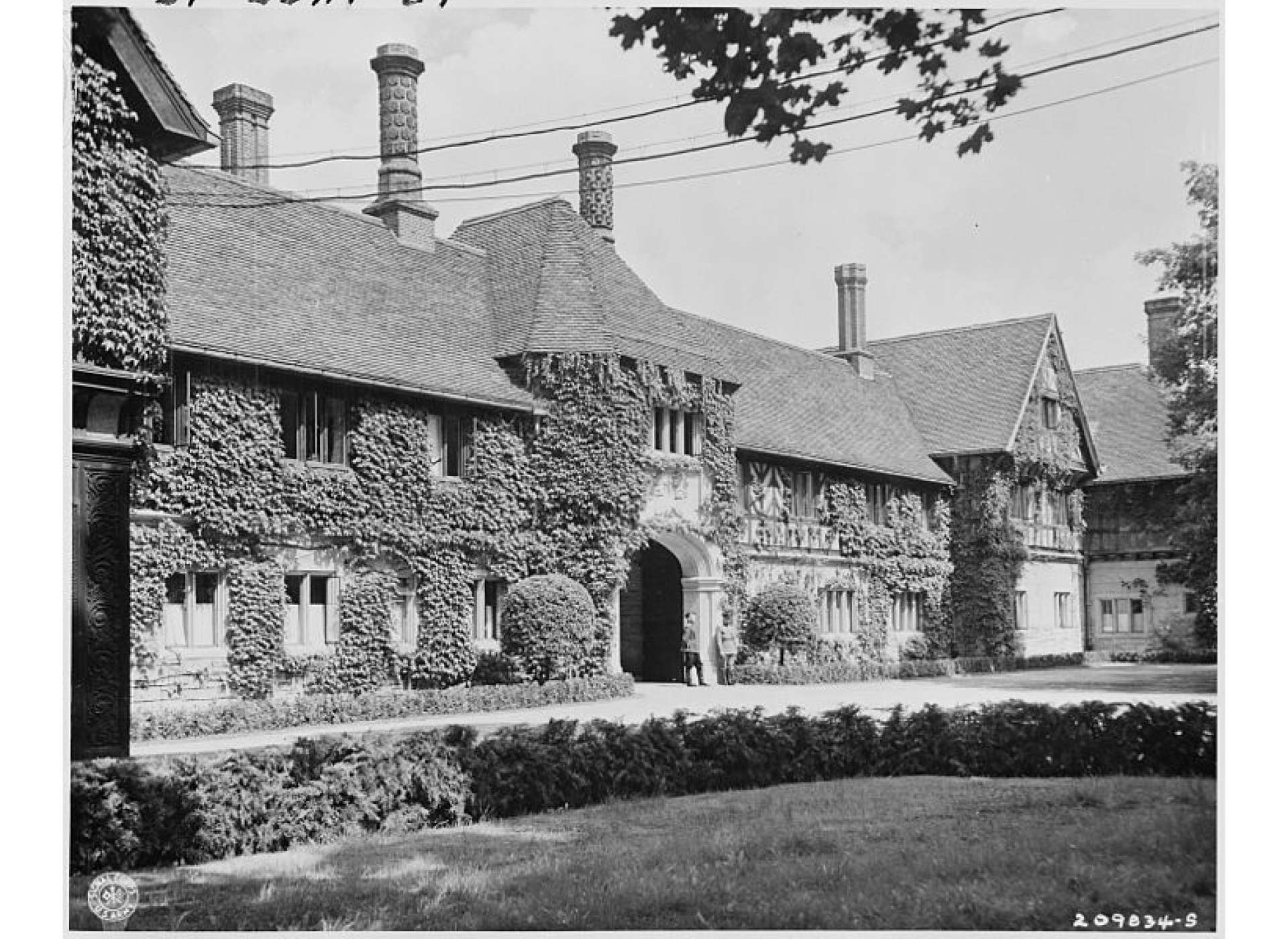
The Schlosse Cecilienhof, Potsdam, Germany, which was the site of the Potsdam Conference. Schlosse Cecilienhof was formerly the palace of the wife of Wilhelm II, Crown Prince of Germany. “The Schlosse Cecilienhof, Potsdam, Germany,” July 13, 1945, National Archives and Records Administration, Office of Presidential Libraries, Harry S. Truman Library, (NAID) 198948.
Already before the Potsdam Conference, the reconfiguration of social and political life in the western and eastern parts of Germany was becoming increasingly divergent, which caused both sides to regard the other with deep suspicion. While American and British officers in charge of civil administration selected and approved persons for official posts who shared similar ideals to those of the United States and Soviet Union, Russians in the Soviet zone supported “anti-fascist democratic parties” similar to those they were nurturing in eastern and southeastern Europe. The German Communist Party was also officially restored in the Soviet zone and led the effort to form a united front with liberal and leftist parties.
As a result, the Soviet press reported that the United States and Britain were being too indulgent to former Nazis by allowing Germans who had served in the government under Hitler to remain in local government positions. In turn, the Western Allies suspected the Soviet Union of using former Nazi officials and military officers for their own devious purposes. According to Herbert Feis, both sides “were roughly of one mind as regards the suppressive elements in the program for control of Germany. But they were apart in their conceptions of the new society to be formed in Germany under their supervision.”
Reparations and economic rehabilitation proved to be the major source of disagreement in this regard, which revealed how each of the Big Three viewed the role of Germany in postwar Europe. At Yalta the Soviets had pressed for heavy postwar reparations—half of which would go directly to the Soviet Union—which Roosevelt had agreed to (although he argued for reparations in kind). Stalin’s goal was to dismantle Germany and destroy its infrastructure so the country would never again pose a threat to European peace and stability. To punish the guilty nation and provide the victims of Nazi crimes with the appropriate compensation for their suffering, Stalin and his foreign minister, Vyacheslav Molotov, advocated for harsh reparations, large territorial losses, and the complete destruction of Germany’s industry.
Churchill and Truman, however, promoted a more lenient proposal, insisting that harsh economic policies and high financial penalties would further destabilize Europe. Both Truman and his Secretary of State James Byrnes, as well as other leading experts, argued that the harsh reparations imposed by the Treaty of Versailles after World War I had handicapped the German economy and contributed to the rise of National Socialism. They worried that a weak Germany would lead to a stronger Soviet Union and, therefore, favored policies to ensure economic stability in Germany.
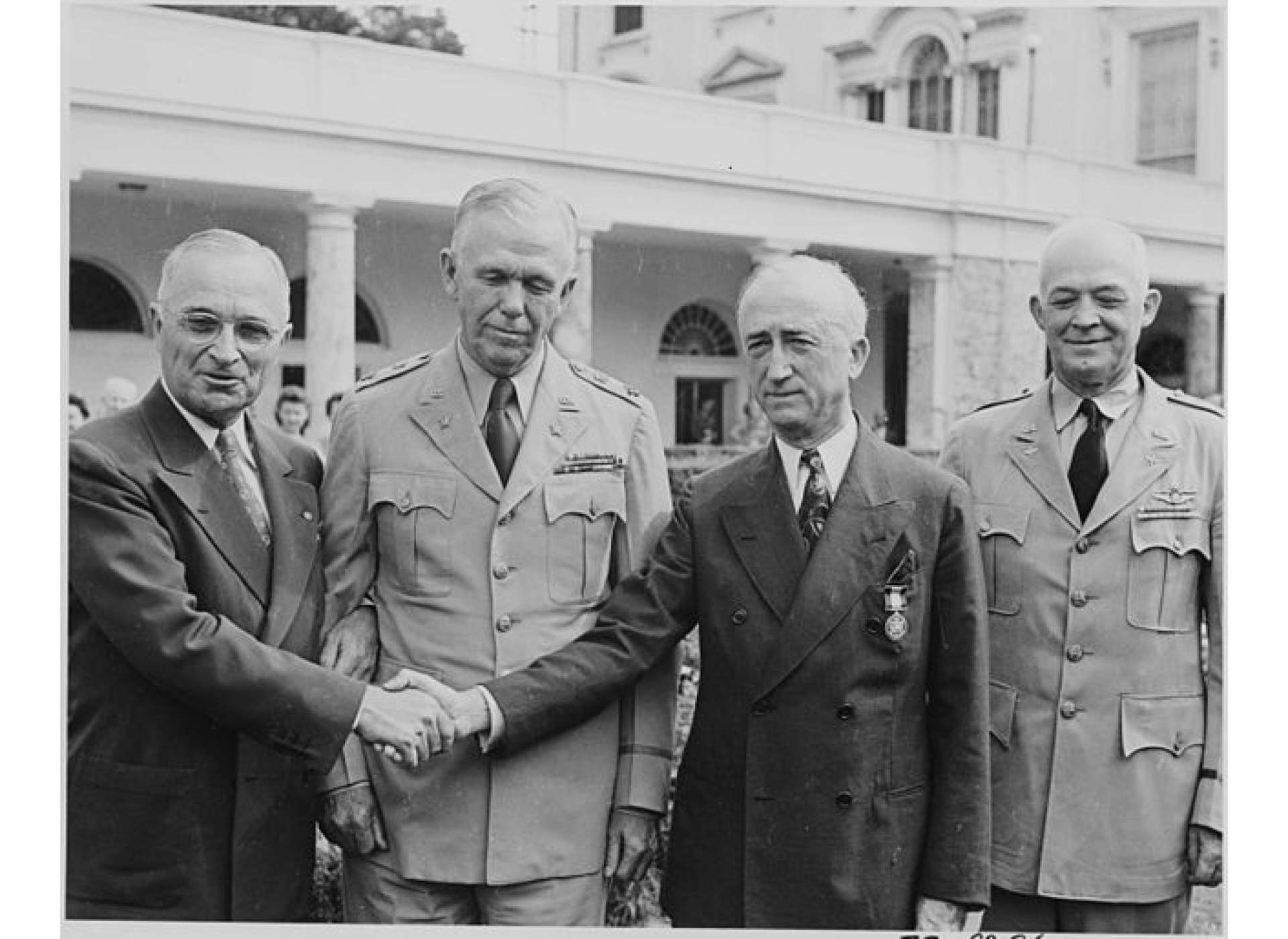
“Photograph of President Truman shaking hands with Secretary of State James F. Byrnes after awarding him the Distinguished Service Medal,” August 13, 1945, National Archives and Records Administration, Office of Presidential Libraries, Harry S. Truman Library, (NAID) 199180.
In order to lessen the extraction of reparations, Truman and Byrnes supported a plan in which each occupying nation would extract reparations from their own zone of occupation. Under this plan, which was eventually agreed to by all four occupiers, The United States and Britain could reduce or even waive reparation payments, thus relieving the United States from the financial burden of caring for the German population by keeping key resources in the western occupied zones. The plan would also protect German industry, as the most valuable factories and mines were located in the western parts of Germany.
Byrnes’ plan, however, doomed the eastern parts of Germany under Soviet occupation since the Red Army had already begun dismantling industrial centers and shipping entire factories to the Soviet Union. Soviet officials also encouraged soldiers to take anything as booty, including items with no military or economic utility. Nonetheless, the agreement to have each occupying power extract reparations from their own zones effectively handled the tricky issue of reparations.
Despite the disagreements surrounding economic rehabilitation and reparations, the British delegation, Stalin, and Truman easily reached several agreements concerning Germany at Potsdam. First, according to the Protocol of the Conference there was to be “a complete disarmament and demilitarization of Germany,” including the elimination of all military and paramilitary forces and the prohibition of any “production of military hardware in Germany.” Second, the three heads of government decided that German society was to be remade along democratic lines. To achieve this, all democratic parties were encouraged to participate in local and state administration and all laws from the Nazi era repealed. Finally, the Allies agreed to arrest and prosecute “those Germans deemed to be war criminals.”
Poland
The other main stumbling block at Potsdam was the postwar fate of Poland and the revision of the country’s borders with the Soviet Union and Germany. The question of Poland had loomed large at Teheran and Yalta. At Teheran, Churchill and Roosevelt agreed to draw the eastern border between Poland and the Soviet Union at the Curzon Line (see map below), which gave huge swaths of prewar Polish territory to Russia. Stalin argued that the Curzon Line best represented the ethnic boundaries of the region and would give Russia a buffer zone for strategic security. Roosevelt and Churchill, and later Truman and Attlee, where unwilling to risk a dispute over Poland’s postwar borders lest it turn into another continental war.
In exchange for the territory Poland lost to the Soviet Union, Poland was compensated in the west with large areas of prewar German territory up to the border along the Rivers Oder and Neisse (see map below). These areas included the former German regions of Silesia, Pomerania, and East Prussia. This “slide to the west” gave Poland a coastline on the Baltic Sea and a sizeable number of natural resources, which the Western Allies hoped would allow Poland to emerge as a potentially powerful buffer state between Germany and Russia.
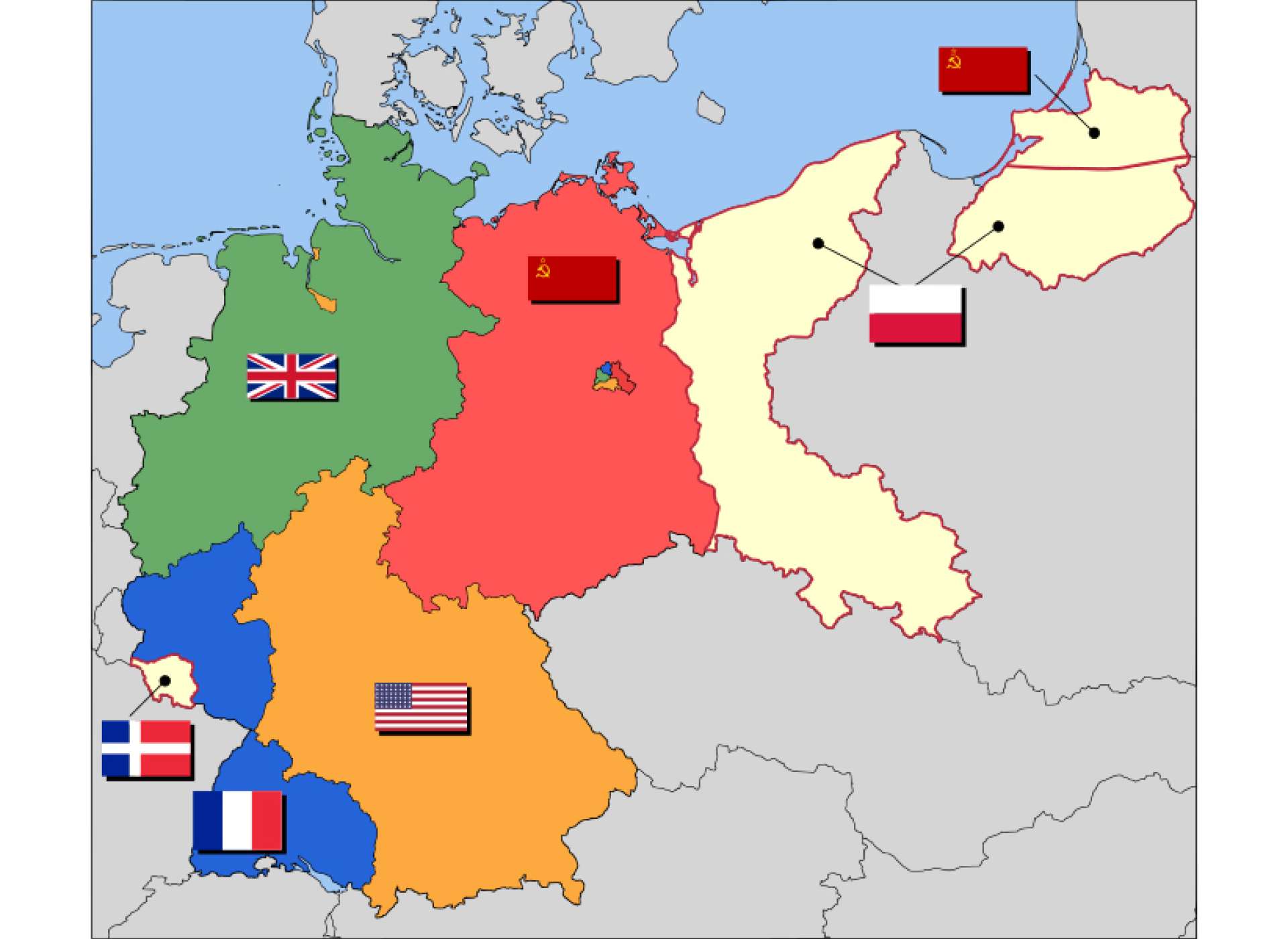
Occupation zone borders in Germany, 1947. The territories east of the Oder-Neisse line, under Polish and Soviet administration/annexation, are shown as cream as is the likewise detached Saar protectorate. Berlin is the multinational area within the Soviet zone. “Map of Germany, 1947,” Andreas Kunz, B. Johnen and Joachim Robert Moeschl, March 2008, University of Mainz, IEG-Maps project.
The composition of Poland’s postwar government was the biggest source of discord between the Big Three, since as Neiberg argues, “more than any other issue discussed at Potsdam, Poland added to the mistrust building between the West and the Soviet Union.” On the one hand, the United States and Britain supported the democratic Polish government, which had been exiled to London during the war. On the other hand, Stalin recognized the Soviet-backed Polish Committee of National Liberation (PKWN), also known as the Lublin Committee, as the legitimate government of Poland, which had been established in July 1944.
At the same time, the Soviet Union had taken important steps to increase its control over Poland such as creating a new Polish currency under the authority of the PKWN and enacting communist reforms in agriculture. The government in Lublin also signed an agreement with the Soviet Union to move all ethnic Poles west of the Curzon Line, resulting in almost 1.5 million Poles being forcibly evacuated from the new Russian borders. Conversely, Poland expelled millions of Germans from their newly gained territories in the west.
Even though Western leaders worried about the Soviet Union’s heavy hand in Polish affairs, again, the United States and Britain were unwilling to risk another war over the issue because Stalin had made it clear that “by the blood of the Soviet people abundantly shed on the field of Poland and in the name of the liberation of Poland” he would not back down on the issue. The question of what constituted a “democratic Poland,” was never agreed upon and the issue (as with a number of other issues raised at Potsdam) was turned over to the Council of Foreign Ministers to try and resolve, leaving the Western Allies to hope for at least “an external appearance of Polish independence.”
The Potsdam Declaration on Japan
Another goal the Western Allies had at Potsdam was to get Stalin to end the Soviet nonaggression pact with Japan and declare war as soon as possible. At the time, both the United States and Britain believed they needed Soviet help to end the war in the Pacific. Consequently, at Potsdam, the Combined Chiefs of Staff set November 15, 1946, as the estimated date for ending the war with Japan, with Stalin promising that the Red Army would invade Manchuria no later than mid-August 1945.
For compensation, Stalin wanted an immediate share of the German merchant fleet in order to move military assets from Europe to Asia, which Truman agreed to. Truman also promised Stalin that he would transfer 20 bomber squadrons to Asia and not conduct any military operations in Korea or the Kurile Islands (a tacit recognition that they fell within the Soviet sphere of influence). In turn, Stalin promised favorable trade terms in Manchuria, insisted he had no intention of occupying any parts of China, and promised the Soviet Union would not interfere with America’s “open door policy” in China.
With the successful test of an atomic bomb on July 16, 1945, however, the Allies issued the Potsdam Declaration. The Declaration pledged that if Japan surrendered, it would retain sovereignty over the home islands of Honshu, Hokkaido, Kyushu, and Shikoku and promised that the Japanese people would have “the opportunity to lead peaceful and productive lives.” The Declaration reiterated this second point by maintaining, “we do not intend that the Japanese shall be enslaved as a race or destroyed as a nation.” While the document stated that Japanese militarists and war criminals would be prosecuted, it did not explicitly mention the emperor, which left open the possibly of the emperor staying on the throne in some capacity.
According to Neiberg, “the declaration was a political document, aimed at domestic audiences demanding harsh terms, but at the same time giving the Japanese a reason to surrender rather than fight on.” Japan saw the Declaration as a political ultimatum and rejected it as the Allies expected, after which Truman authorized the use of atom bombs on Japan.
Conclusion
Herbert Feis argues that the heads of the British, United States, and Soviet governments did not “draw together at Potsdam in the same warm, personal association in a common cause as the two wartime meetings at Teheran and Yalta.” During the war, the Allies were bound by mutual military dependence, but once the war ended, “differences of memory and interest, and visons of a good public and private life, proved to be too deep to make genuine ? possible once the common danger was past.”
The Western Allies feared Soviet Communist domination over Europe and Stalin believed that the West wanted to deprive the USSR of the benefits of its victory. The US and Britain were also alarmed by the ways in which the Soviet Union was seeking to expand its sphere of influence beyond Central and Eastern Europe by its effort to get Norway to turn over Spitzbergen; its bid for one of the Italian colonies in North Africa; its demand for control of the Black Sea Straits; its “menacing ways in Iran;” and a plan to extort from China special privileges in Manchuria and Korea.
Some leaders such as Atlee and Kennan accurately predicted a future conflict between the Soviet Union and the West, but it is important to remember that despite areas of disagreement, each of the Big Three left Potsdam optimistic that they had solved the central problems as they existed during the time. While the Potsdam Conference did not answer all the questions stemming from the end of World War II, it did, nonetheless, as Byrnes stated, establish “a basis for maintaining our war-born unity [with the Soviet Union] and provided a basis for the early restoration of stability to Europe.”
Jennifer Popowycz, PhD
Jennifer Popowycz, PhD is the Leventhal Research Fellow at The National WWII Museum. Her research focuses on the Eastern Front and Nazi occupation policies in Eastern Europe in World War II.
Cite this article:
MLA Citation:
APA Citation:
Chicago Style Citation:
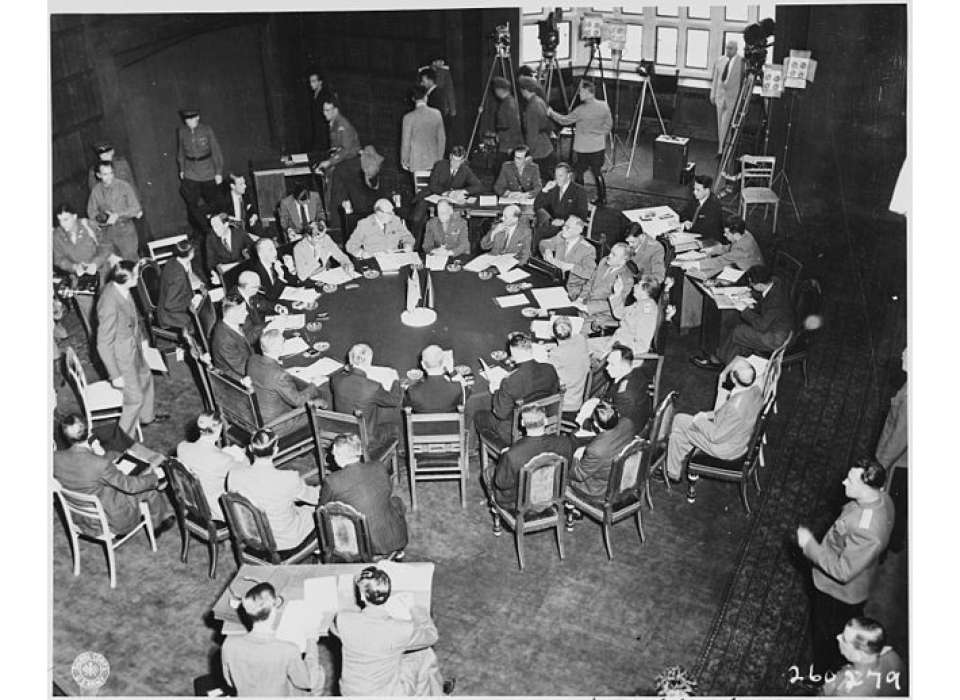




![Max Fuchs, New York City cantor, sings as Rabbi Sydney [sic] Lefkowitz, Richmond, VA, conducts the first Jewish services from Germany.](/sites/default/files/styles/max_650x650/public/2025-10/image1.jpg)



